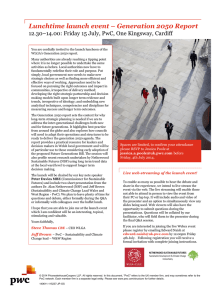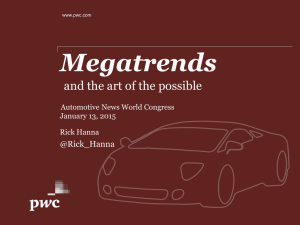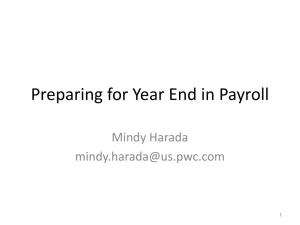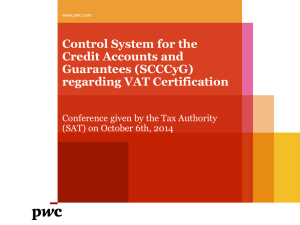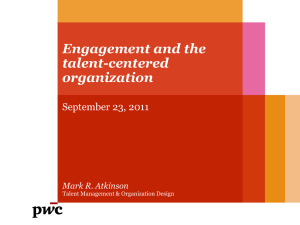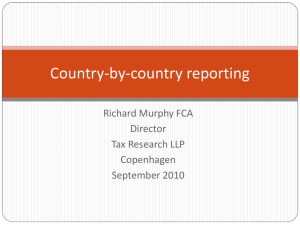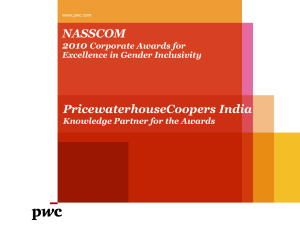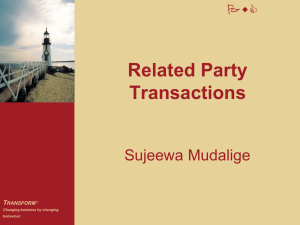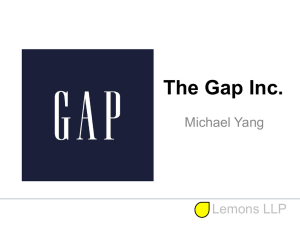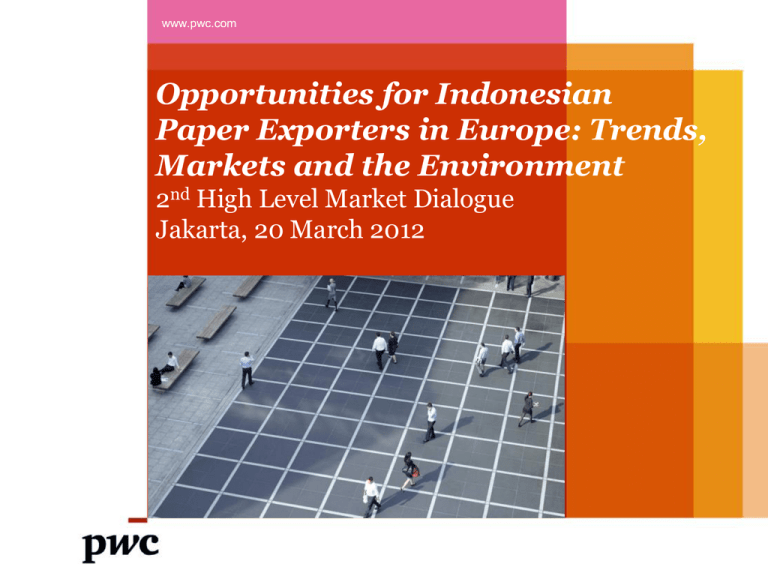
www.pwc.com
Opportunities for Indonesian
Paper Exporters in Europe: Trends,
Markets and the Environment
2nd High Level Market Dialogue
Jakarta, 20 March 2012
Topics
• Global and European demand trends
• European market characteristics
• How does Indonesia stack up and what is the opportunity for its
producers
• Concluding thoughts
PwC LLP
Slide 2
Global paper and board demand has grown
by nearly 25% in the last decade
450
400
Million tons
350
300
Other P&B
250
Containerboard
Tissue
200
P&W
Newsprint
150
100
50
0
2000
PwC LLP
2002
2004
2006
2008
Source: RISI
2010
2012
Slide 3
But growth has faltered since the financial
crisis and outlook is tepid(% change)
-covers newsprint, printing & writing, paperboard, tissue
and specialities
Source: RISI
PwC LLP
Slide 4
The longer term outlook shows growth below GDP
but some grades have better prospects than
others: Averageannual growth rates 2010 Europe c. 88
mn tons or 26% of
Global
• Paper intensity of growth is
reducing,
• Growth available concentrated in
emerging markets
Source: RISI 2010
PwC LLP
Slide 5
Europe well illustrates the variable growth
patterns for different paper grades
2009
2010
2011
2012
2013
Europe (mn tons)
33.2
35.9
35.1
33.7
33.3
% change
-14.4
8.1
-2.2
-4.1
-1.0
World (mn tons)
104.2
110.3
109.8
110.7
113.3
% change
-9.0
5.8
-0.5
0.9
2.3
Europe’s share (%)
31.9
32.5
31.9
30.4
29.3
Europe (mn tons)
7.7
8.0
8.3
8.6
8.8
% change
-1.0
4.9
3.0
3.4
3.1
World (mn tons)
27.9
29.2
30.5
31.7
32.9
% change
1.1
4.5
4.1
4.2
4.1
Europe’s share (%)
27.5
27.3
27.2
27.1
26.8
P&W papers
Tissue papers
PwC LLP
Source: RISI
Slide 6
Taking a closer look, the EU paper industry is a
EUR 72 bn sector. It is a large importer of pulp and
a large exporter of paper
EURbn
2006
2007
2008
2009
2010
Exports
1.1
1.1
1.1
1.0
1.4
Imports
(4.6)
(4.7)
(4.6)
(3.4)
(5.2)
Net imports
(3.5)
(3.6)
(3.5)
(2.4)
(3.8)
Exports
18.7
19.0
19.3
16.9
20.2
Imports
(6.6)
(7.7)
(7.4)
(6.9)
(7.6)
Net Exports
12.1
11.3
11.9
10.0
12.6
Pulp
Paper
Source: EU Market Access Database, CEPI
PwC LLP
c. 20% of
pulp needs
are
imported
And c.
20% of
paper
output is
exported
With an aggregate value of
over EUR12 bn,the import
market for pulp and paper is
substantial
Slide 7
Pulp comes from the West but paper goes
everywhere-major EU Trade partners(2010)
Pulp
EUR bn
PaperEURbn
Net
exports
Net
Imports
Net
exports
Brazil
1.9
Russia
1.8
USA
1.2
Turkey
1.0
Chile
0.6
China
China
0.5
Canada
Uruguay
Indonesia is a net buyer of
pulp and in 2010 of paper too.
With waste paper on top, the
EU is an important supplier
of fibre
0.7
0.5
USA
0.6
0.3
Australia
0.6
India
0.4
24
Gross exports/imports
72
48
% of EU total
5%
1%
PwC LLP
0.7
Ukraine
Indonesia (EUR mn)
Source: EU Market Access Database
Net
imports
EU duties
on imports
of Chinese
coated P&W
papers wef
2011 will
reduce the
net import
balance
Indonesia (EUR mn)
1
Gross exports/imports
172
171
% of EU total
1%
2%
Slide 8
Looking deeper at some European market trends,
we can see the decline in end use consumption in
publications
Source: RISI
PwC LLP
Slide 9
..... as screens become the new paper
Source: Gerd Leonard PRIMA Berlin May 2011
PwC LLP
Slide 10
The European supply base must still adjust to
lower demand, notably in publication papers
Source: Cepiprint, Cepifine, UPM
PwC LLP
Slide 11
And with sales prices lagging cost rises,
European papermaking margins are under
pressure
PwC LLP
Source: Hawkins Wright Pulpwatch, March 2012
Slide 12
The EU Market is increasingly environmentally
and socially concious
The end of waste
•
Strong development of recycling, with European paper recycling rate now 69%
(2010) , up from 52% in 2000. EU target of 70% by 2015
•
54% of paper and board made from the “urban forest”
• Forests are expanding- net forest expansion of 512,000 ha, 2005-10
• Virgin fibre -legal and sustainable
•
CEPI * Code of Conduct on Legal Logging(2005) adopted by all national assns
•
62% of wood virgin fibre usage is certified(2010), up 5% in two years
•
Near 100% of corporate owned or managed forests in Europe certified
•
96% of market pulp, 70% of P&B capacity covered by C of C certification
• Broad stakeholder engagement
•
For consumers, sustainability is increasingly taken as the new norm
•
Companies engage in wide social dialogue with civil society including NGOs
* Confederation of European Paper Industries
PwC LLP
Slide 13
Getting Indonesia in perspective- Major pulp
and paper producer countries (2009)
Paper(mn tons)
Pulp (mn tons)
USA
48.3
China
86.4
China
20.8
USA
71.6
Canada
17.1
Japan
26.3
Brazil
13.3
Germany
20.9
Sweden
11.5
Canada
12.9
Finland
9.0
Sweden
10.9
Japan
8.5
Finland
10.6
Russia
7.2
South Korea
10.5
Indonesia
6.0
Brazil
9.4
Chile
5.0
Indonesia
9.4
Global total
178
Global total
371
>3% of
global
pulp;
2.5%
of
global
P&B
Source: RISI
PwC LLP
Slide 14
How competitive is Indonesia?
BHKP *cash costs (delivered to W Europe cif)
750
650
Indonesia compares well
with its low cost peers
in Brazil and Chile on
in-mill costs
Marketing & Sales
Freight
US$ per tonne
550
Other mill costs
450
Maintenance
350
Labour
250
Energy
150
Chemicals
50
Wood
-50
...but loses out on wood
costs
* Bleached hardwood kraft pulp
Source: Hawkins Wright, Feb 2012
PwC LLP
Slide 15
So how do Indonesia and Brazil compare?
Indonesia
Brazil
Population (mn 2012 est)
248
206
Area (mn km²)
1.9
8.5
GDP
834 billion
2,500 billion
GDP per capita ($ at PPP 2011 est)
4,700
11,600
Ranking for ease of doing business( 2011
129
126
Corruption perception index –rating out
of 10 ( 2010 ranking out of 178 countries in brackets)
2.8(110)
3.7(69)
Top environmental issue
Deforestation
Deforestation(of
Amazon)
Forest cover (% of land area with forest)
52
65
Planted forest area-mn ha( % of total forest cover
3.5( 3%)
6.3 (3%)
0.5( 14%)
2.7( 43%)
($ at official ex rate-2011 est)
out of 184 countries)
in brackets)
Plantations –certified area - mn ha est (%
certified in brackets)
Sources: CIA Handbook, Transparency Int’l, World Bank, FAO Resources Assessment 2010,FSC, PEFC, BRACELPA
PwC LLP
Slide 16
The key Brazilian players are a mixture of
domestic and foreign companies
Domestic
Foreign
Fibria ¹
• Arauco (Chile)²
Suzano¹
• CMPC ( Chile) ²
Klabin¹
• Rigesa ( Meadwestvaco USA) ²
Duratex ¹
• International Paper (USA) ²
Joint Ventures
• CENIBRA- Japanese consortium co
• Veracel- Fibria: StoraEnso(Finland) ²
50:50
¹Publicly listed on the Brazil stock exchange .Most though remain
close/family controlled
² Publicly listed on home stock exchanges; the two Chilean cos, are also NYSE
listed although remain family controlled
PwC LLP
Slide 17
Concluding thoughts
EU is a large but mature market-some sectors in decline; others still growing
• EU an open market, with well developed trade channels internally and
externally
• EU is oversupplied domestically. But there will be more disinvestment than
investment , creating opportunities for competitive external suppliers
• Stakeholders in pulp and paper in the EU are environmentally and socially
concious; EU corporates have a high degree of public accountability and
responsibility
• Exporters to the EU will need to be competitive not just on price and product
performance, but also in terms of corporate responsibility-the Latin
American exporters are well down that road.
• Indonesia would seem to have the basis for being cost competitive in Europe
but is this enough?
• Ensuring that pulp and paper supplies are sourced and processed from
legally sourced and processed wood is a good foundation but only the start of
the whole journey.
PwC LLP
Slide 18
Key contacts
Clive Suckling,
UK & Global Leader, Forest ,Paper &
Packaging Industry
tel: +44 (0)20 7213 4887
clive.r.suckling@uk.pwc.com
This publication has been prepared for general guidance on matters of interest only, and does not constitute professional advice. You should not act upon the information
contained in this publication without obtaining specific professional advice. No representation or warranty (express or implied) is given as to the accuracy or completeness
of the information contained in this publication, and, to the extent permitted by law, PricewaterhouseCoopers LLP, its members, employees and agents do not accept or
assume any liability, responsibility or duty of care for any consequences of you or anyone else acting, or refraining to act, in reliance on the information contained in this
publication or for any decision based on it.
© 2011 PricewaterhouseCoopers LLP. All rights reserved. In this document, “PwC” refers to PricewaterhouseCoopers LLP (a limited liability partnership in the United
Kingdom) which is a member firm of PricewaterhouseCoopers International Limited, each member firm of which is a separate legal entity.

